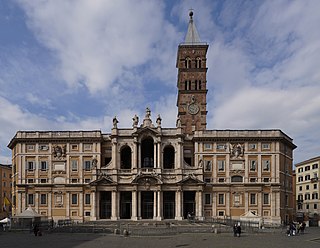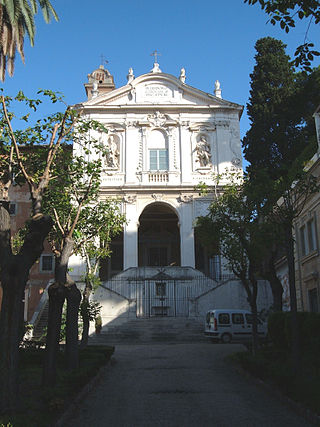Architecture
Renovations began on the old monastery in 1545, but it soon became clear that the building was too small. Designed by Galeazzo Alessi was commissioned to design its renovation and expansion. It has a nave with barrel vault, finishing in a rectangular presbytery serving as the sanctuary. [3] Construction was completed in 1567, followed by embellishing the interior, which continued into 1568. The first mass was celebrated in 1568 by Archbishop of Milan Charles Borromeo, Cardinal Protector of the Barnabite order, who had himself donated the altar. [4]
There is an altar dedicated to Alexander Sauli, a Superior-General of the Barnabite order (1566–1569) and "Apostle of Corsica". [4]
The interior includes a notable selection of Milanese Mannerist artworks: the Stigmata of St. Francis by Giovan Paolo Lomazzo, a Pietà by Aurelio Luini and, flaking the high altar two large canvasses of Histories of St. Paul and Barnaba, Simone Peterzano's (1572–1573). [4]

Barnabas, born Joseph (Ἰωσήφ) or Joses (Ἰωσής), was according to tradition an early Christian, one of the prominent Christian disciples in Jerusalem. According to Acts 4:36, Barnabas was a Cypriot Jew. Named an apostle in Acts 14:14, he and Paul the Apostle undertook missionary journeys together and defended Gentile converts against the Judaizers. They traveled together making more converts, and participated in the Council of Jerusalem. Barnabas and Paul successfully evangelized among the "God-fearing" Gentiles who attended synagogues in various Hellenized cities of Anatolia.

The Papal Basilica of Saint Paul Outside the Walls is one of Rome's four major papal basilicas, along with the basilicas of Saint John in the Lateran, Saint Peter's, and Saint Mary Major, as well as one of the Seven Pilgrim Churches of Rome.

The Basilica of Saint Mary Major, or church of Santa Maria Maggiore, is a Major papal basilica as well as one of the Seven Pilgrim Churches of Rome and the largest Catholic Marian church in Rome, Italy.

The Barnabites, officially named as the Clerics Regular of Saint Paul, are a religious order of clerics regular founded in 1530 in the Catholic Church. They are associated with the Angelic Sisters of Saint Paul and the members of the Barnabite lay movement.

Anthony Maria Zaccaria, CRSP was an early leader of the Counter Reformation, the founder of religious orders (Barnabites) and a promoter of the devotion to the Passion of Christ, the Eucharist and the renewal of the religious life among the laity. He is venerated as a saint in the Catholic Church, which celebrates his feast day on 5 July.

The Theatines, officially named the Congregation of Clerics Regular, is a Catholic order of clerics regular of pontifical right for men founded by Archbishop Gian Pietro Carafa on 14 September 1524.

Sant'Eusebio is a titular church in Rome, devoted to Saint Eusebius of Rome, a 4th-century martyr, and built in the Esquilino rione. One of the oldest churches in Rome, it is a titular church and the station church for the Friday after the fourth Sunday in Lent.

Alexander (Alessandro) Sauli, C.R.S.P. was an Italian priest who is called the "Apostle of Corsica". He is a saint of the Roman Catholic Church. In 1571, he was appointed by Pius V to the ancient see of Aléria, Corsica, where he rebuilt churches, founded colleges and seminaries, and, despite the depredations of corsairs, placed the Church in a flourishing condition.
Clerics regular are clerics who are members of a religious order under a rule of life (regular). Clerics regular differ from canons regular in that they devote themselves more to pastoral care, in place of an obligation to the praying of the Liturgy of the Hours in common, and have fewer observances in their rule of life.

The Guastallines are members of the College of Guastalla, a Roman Catholic congregation for women, founded in Milan.

San Carlo ai Catinari, also called Santi Biagio e Carlo ai Catinari, is an early-Baroque style church in Rome, Italy. It is located on Piazza Benedetto Cairoli, 117 just off the corner of Via Arenula and Via dei Falegnami, a few blocks south of the church of Sant'Andrea della Valle.

San Paolo Converso is a former Roman Catholic church in Milan, region of Lombardy, Italy, now utilized as a contemporary art space.

San Marco is a church in Milan, northern Italy.

The Angelic Sisters of Saint Paul are a Roman Catholic religious order founded by Anthony Maria Zaccaria in Milan, Italy in 1535.

The Santa Maria Maddalena is a Roman Catholic church in Rome, named after Saint Mary Magdalene. It is located on the Via della Maddalena, one of the streets leading from the Piazza della Rotonda in the Campo Marzio area of historic Rome. It is the regional church for the people of Abruzzo.
San Marino is a small landlocked country with an area of about 61.2 km2 (23.6 sq mi) on a rocky promontory at an elevation of 657 meters (2,156 ft) in central Italy. In 2023, the population was 33,636. It is the third smallest country in Europe after Vatican City and Monaco. It is traditionally held to have been founded as a republic in 301 AD, was recognized by the Papacy in 1631, and became a member of the United Nations in 1992. As of 2009, the ethnic composition was about 84.95% Sammarinese, 14.6% Italians and others.

Sant'Isidoro a Capo le Case is a Roman Catholic church, monastic complex and college of the Franciscan Order, in the Ludovisi district on the Pincian Hill in Rome. It contains the Cappella Da Sylva, designed by Gian Lorenzo Bernini, who also designed the funerary monument of his son Paolo Valentino Bernini in it. Since 2017 San Patrizio a Villa Ludovisi became the national church of the United States, Sant'Isidoro has become the National Church of Ireland in Rome.

The Abbey of Santa Giustina is a 10th-century Benedictine abbey complex located in front of the Prato della Valle in central Padua, region of Veneto, Italy. Adjacent to the former monastery is the basilica church of Santa Giustina, initially built in the 6th century, but whose present form derives from a 17th-century reconstruction.

San Barnaba is a Roman Catholic church located at the intersection of Via Giovanni Chiassi and Via Carlo Poma in Mantua, Lombardy, Italy.

San Paolo Maggiore, also known as San Paolo Decollato, is a Baroque-style, Roman Catholic basilica church located on Via Carbonari #18 in Bologna, region of Emilia-Romagna, Italy.




















